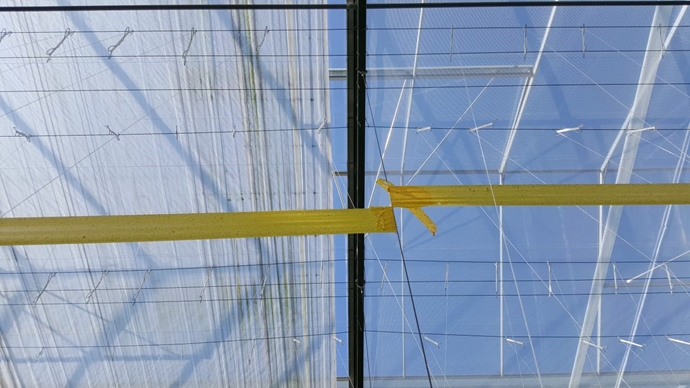Extending the Life of Your Greenhouse Covering
We normally like growers to focus on their crop, its quality and yields, which is the essence of their business and what pays the bills at the end of every season. However, an easy rule to follow is that at least once a year, growers need to “look up” and check on the coverings, shades and energy curtains in their greenhouse. What do you have to look for and how can you maximize a possible replacement?
Pictured: Old energy curtain on the left, brand new Luxous 1147 from Svensson on the right.

Here are some recommendations:
• Let’s start with the obvious points and make sure the energy curtains don’t show any substantial rips or holes. By now you’ve probably been heating your greenhouses for a few months and those rips on the fabric could be the reason your gas bill is unusually high. Patching a hole here and there is a good business practice, but is patching 20 to 30 holes the best use of your labor?
• Light reduction. So you had a great installer 10 years ago and the fabric looks as it was installed “yesterday.” That could be the case and you should keep doing business with that company, but have you measured the light levels on the greenhouse lately? Any product will lose light transition every year due to its exposure to UV radiation, dust, pollen, water, etc. Most likely after 10 years, you’re getting 60% of the initial light that you were getting from the new product. Light has a direct correlation with production of any crop, so maybe it’s time for a change.
• Rebates. Yes, you heard right—rebates! Most states in the U.S. and Canada have very good (yet unknown) rebate programs. They not only apply to new buildings, but also toward energy curtain replacement. Check with your local energy company to be sure, but most of the rebates that we see start six to eight years after the screen is installed. This might help you get a new product at a fraction of the original cost.
• Technology changes every year. It’s likely there’s a newer material out there now that controls humidity better or diffuses light more evenly throughout the crop compared to your current curtain you installed seven or eight years ago. Aluminum curtains that were always a necessity have lost a lot of terrain against more modern and fire-rated light diffusion films.
• Survey your facility. Knowing exactly what you have is the best way of planning for the future. It doesn’t matter if you have hundreds of acres or a couple of hoop houses. Most installers and curtain companies keep records of the product you purchased and when it was installed. Reach out to those companies for information to set up a possible visit or look for rebates or new products. Stay informed!
Scheduling our equipment replacement should be as normal as scheduling routine maintenance on our cars. There’s nothing more painful than realizing in the middle of January that we still have three more months to go with the heaters and our curtains are looking like our aunt’s pasta strainer. Keep an eye on these things to know if it’s time to upgrade or not and maximize your time, energy and overall savings.
